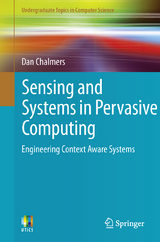Sensing and Systems in Pervasive Computing
Engineering Context Aware Systems
Seiten
2011
Springer London Ltd (Verlag)
978-0-85729-840-9 (ISBN)
Springer London Ltd (Verlag)
978-0-85729-840-9 (ISBN)
Pervasive Computing is an important area in current computer science research and industrial development.
Sensing and Systems in Pervasive Computing brings together these issues in a practical form for the undergraduate or postgraduate -- describing the core ideas and providing programming exercises which explore these issues.
Pervasive Computing is an important area in current computer science research and industrial development. It relates to smart phones, sensors and other computing devices which, by being sensitive to the user, are disappearing into the background of life. The computing systems challenges are significant and it is here (rather than on life or social sciences, interaction design, electronics or formal approaches) that this book focuses. Success requires considering a broad range of issues, including:
Low power and a wide range of different hardware;
Personal and local area wireless networking and networks of smart sensors;
Location sensing and handling located data;
Adaptation to the environment, or context, in various ways;
Data processing which considers state, events, time-varying signals and noise;
Systems design for scalability and handling variation, beyond Internet scales.
Sensing and Systems in Pervasive Computing brings together these issues in a practical form for the undergraduate or postgraduate -- describing the core ideas and providing programming exercises which explore these issues. Many of the programming exercises are described in terms of the Phidgets sensor interfacing kits, but are easily adapted to other hardware. The references refer to recent research, but focuses on more established principles rather than the latest technology in the selection of ideas. Each chapter is accompanied by suggested readings, guiding the student into the large body of scientific papers in this area.
Depending on the emphasis given, Sensing and Systems in Pervasive Computing, can be used to support an introduction tothe use of sensors; an advanced course on pervasive computing and research techniques; or to give an introduction to the area for research students. The approach taken includes mathematics where necessary without being overly technical, and includes guidance on problem solving and experimental techniques which some computing undergraduates seem to miss.
Sensing and Systems in Pervasive Computing brings together these issues in a practical form for the undergraduate or postgraduate -- describing the core ideas and providing programming exercises which explore these issues.
Pervasive Computing is an important area in current computer science research and industrial development. It relates to smart phones, sensors and other computing devices which, by being sensitive to the user, are disappearing into the background of life. The computing systems challenges are significant and it is here (rather than on life or social sciences, interaction design, electronics or formal approaches) that this book focuses. Success requires considering a broad range of issues, including:
Low power and a wide range of different hardware;
Personal and local area wireless networking and networks of smart sensors;
Location sensing and handling located data;
Adaptation to the environment, or context, in various ways;
Data processing which considers state, events, time-varying signals and noise;
Systems design for scalability and handling variation, beyond Internet scales.
Sensing and Systems in Pervasive Computing brings together these issues in a practical form for the undergraduate or postgraduate -- describing the core ideas and providing programming exercises which explore these issues. Many of the programming exercises are described in terms of the Phidgets sensor interfacing kits, but are easily adapted to other hardware. The references refer to recent research, but focuses on more established principles rather than the latest technology in the selection of ideas. Each chapter is accompanied by suggested readings, guiding the student into the large body of scientific papers in this area.
Depending on the emphasis given, Sensing and Systems in Pervasive Computing, can be used to support an introduction tothe use of sensors; an advanced course on pervasive computing and research techniques; or to give an introduction to the area for research students. The approach taken includes mathematics where necessary without being overly technical, and includes guidance on problem solving and experimental techniques which some computing undergraduates seem to miss.
Introduction.-Pointers on Experiments and Results.-Hardware for Pervasive Computing.-Networks.-Classification and Use of Content.-Error in Sensed Data.-Sources, Models and Use of Location.-Time Dependent Data.-Sensor Networking.-Index.
| Reihe/Serie | Undergraduate Topics in Computer Science |
|---|---|
| Zusatzinfo | 27 Illustrations, black and white; XXI, 173 p. 27 illus. |
| Verlagsort | England |
| Sprache | englisch |
| Maße | 155 x 235 mm |
| Themenwelt | Mathematik / Informatik ► Informatik ► Datenbanken |
| Mathematik / Informatik ► Informatik ► Netzwerke | |
| Informatik ► Theorie / Studium ► Künstliche Intelligenz / Robotik | |
| Schlagworte | Ambient Intelligence • Context Awareness • phidgets • sensors • ubiquitous computing |
| ISBN-10 | 0-85729-840-2 / 0857298402 |
| ISBN-13 | 978-0-85729-840-9 / 9780857298409 |
| Zustand | Neuware |
| Haben Sie eine Frage zum Produkt? |
Mehr entdecken
aus dem Bereich
aus dem Bereich
Buch | Softcover (2024)
REDLINE (Verlag)
CHF 27,95
Eine kurze Geschichte der Informationsnetzwerke von der Steinzeit bis …
Buch | Hardcover (2024)
Penguin (Verlag)
CHF 39,20




